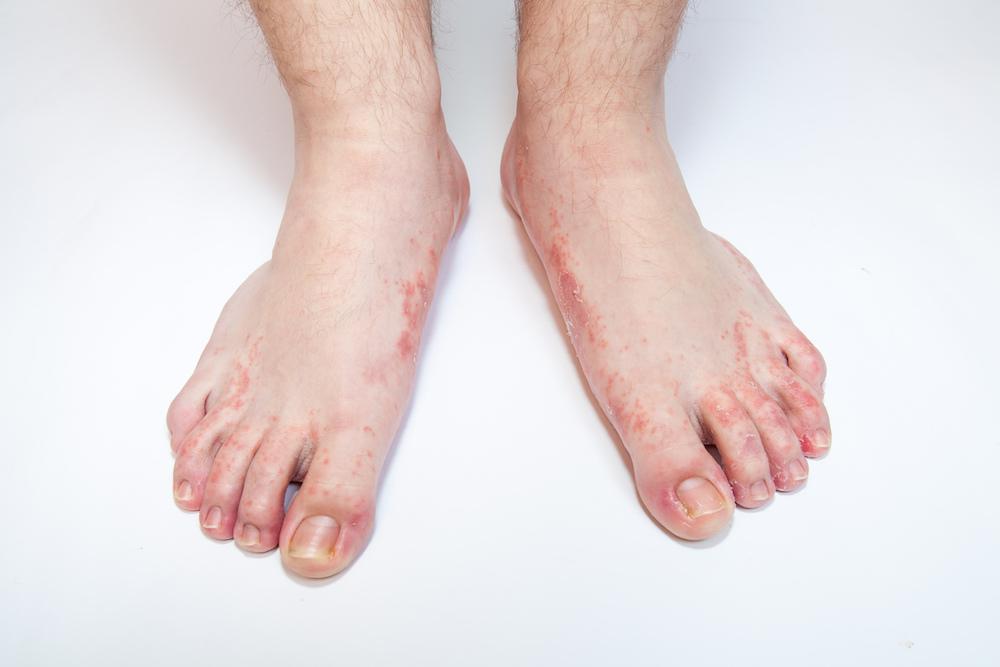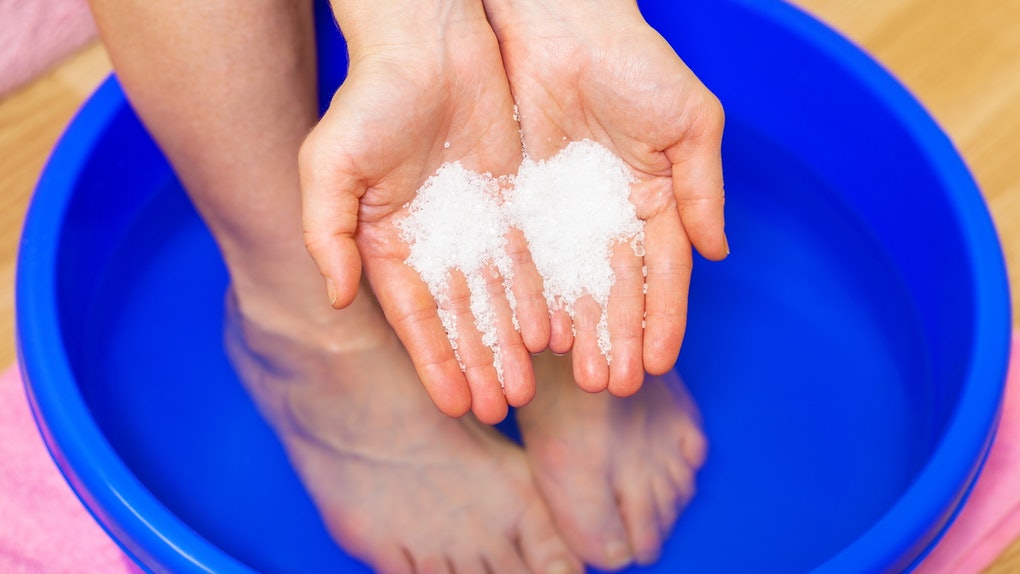Athlete’s foot, also called tinea pedis, is a contagious fungal infection that affects the skin on the feet. It can also be spread to the toenails and the hands. It is a common skin infection of the feet that are caused by fungus. Fungal infection occurs on any part of the body, most of the time on the foot. This fungus attacks the feet because it thrives in a dark, moist, and warm environment, such as a shoe. Fungal infections are more common in warm weather as the feet tend to sweat more, thus giving the fungus more chance to thrive in damp areas, such as swimming pools, showers, and locker rooms. The name Athlete’s foot was given as sweaty and damp feet are that of athletes, and they are ones who use this facility the most.

Why is it called Athlete’s Foot?
It’s Not Exclusive To Athletes, Or Even To The Feet.
Athlete’s foot is a common condition among sportspeople because it thrives in the warm, sweaty places between toes that are regularly cooped up in trainers for hours on end. With so many people wearing trainers for everyday use, the condition is more widespread than ever – around 15% of the adult population have some form of it at any one time, with women making up just under half of them.
In fact, anyone can get Athlete’s Foot. It’s not dangerous, but it can be very itchy and persistent, and, if left untreated, it can spread to other parts of the foot, body and even other people.
What causes Athlete’s Foot?
Athlete’s foot is caused by a fungus that grows on or in the top layer of skin. Fungi (plural of fungus) grow best in warm, wet places, such as the area between the toes.
Athlete’s foot spreads easily. You can get it by touching the toes or feet of a person who has it. But most often, people get it by walking barefoot near swimming pools or in locker rooms. The fungi then grow in your shoes, especially if your shoes are so tight that air cannot move around your feet.

Symptoms
The signs of Athlete’s foot, singly or combined, are dry skin, itching, scaling, inflammation, and blisters. Blisters often lead to cracking of the skin. When blisters break, small raw areas of tissue are exposed, causing pain and swelling. Itching and burning may increase as the infection spreads.
Athlete’s foot may spread to the soles of the feet and the toenails. It can be spread to other parts of the body, notably the groin and underarms, by those who scratch the infection and then touch themselves elsewhere.
What does Athlete’s foot look like?
Athlete’s foot may look like red, peeling, dry skin areas on one or both soles of the feet. Most commonly, the rash is localized to just the soles of the feet. The space between the fourth and fifth toes also may have some moisture, peeling, and dry flakes.
There are three common types of Athlete’s foot:
1. soles of the feet, also called “moccasin” type
2. between the toes also called “inter-digital” type
3. inflammatory type or blistering

How does Athlete’s Foot spread?
Athlete’s foot is spread by contact with materials on which the fungus is present such as floors, footwear and bedding. It can also stay alive on these surfaces for several days. This means you can contract it simply by walking barefoot through a public shower or locker room. Athlete’s foot is not limited to just the feet, either – it can be spread to the groin (a.k.a. jock itch), and underarms, so don’t scratch, and if you do touch an infected area, immediately wash your hands.
The most common causes of Athlete’s foot are:
Sharing socks or shoes with others
Since Athlete’s foot is a foot fungus, it stands to reason that it can be spread by sharing the footwear of someone infected. The insides of shoes and socks are dark, warm, and often moist – optimal growth conditions for this hearty fungus. Using a foot powder in your socks and shoes can help reduce moisture.
Going barefoot in showers and locker rooms
Many schools have experienced outbreaks of Athlete’s foot due to the fungus being left behind in the shower room and locker room floors. If you have to remove your footwear in these areas, thoroughly wash and dry your feet before putting your shoes back on – or, better yet, invest in a pair of sandals to keep your feet from contacting these common surfaces in the first place.
The skin on skin contact
If you come into direct contact with an infected area of someone else’s body, you will likely contract the fungus. If this happens, immediately wash, and if you want to be extremely careful, apply anti-fungal cream or spray and keep the area as dry as possible.
How to Prevent Athlete’s Foot
There are many ways which you can avoid Athlete’s foot:
Wash your feet – Wash your feet whenever after have come into contact with any common surface, as well as at least once a day.
Keep your feet dry – Foot fungus thrives in moist environments, meaning the dryer your feet, the less hospitable they become like a home for Athlete’s foot. Dry your feet completely after every shower, paying particular attention to the spaces between your toes. You can also use foot powders to help keep them dry as you go about the day’s business.
Go barefoot around the house – The open-air will keep your feet dry and inhospitable to foot fungus. Just remember, barefoot outside and around the house is one thing, but a locker room is a whole other ball game.
Choose the right footwear – Not all socks and shoes are equal. To keep your feet as dry as you can opt for socks and shoes made out of breathable materials like cotton, wool and some leathers. Any synthetic materials and you are much more likely to sweat and make a happy home for this kind of foot fungus.
Wear sandals – These types of open footwear don’t trap moisture. This allows good air circulation and helps to keep the feet much drier throughout the day while still offering protection from potentially infected surfaces.
Never wear the same socks twice – Change your socks or pantyhose every day and wash them in hot water between uses. If you have more than one pair of shoes, you should try wearing a different pair each day. This will allow the last-used pair to dry out before their next use completely.
Getting Rid of Athlete’s Foot

If you prolong getting your foot fungus treated, it can spread to your toenails, and once it has gotten under there, you will have a hard time fighting it off. If this happens, see your doctor and get a prescription – in rare cases, you may even need to get your toenails removed. I don’t have to tell you that this is not the kind of thing you want to go through, ever – so see your doc!
Treatments for Athlete’s foot:
Topical anti-fungal creams, sprays and liquids
These are put directly onto the infected skin several times a day. When you choose a product, follow the instructions that come with it. Most topical anti-fungal solutions contain miconazole, itraconazole, or terbinafine. They can take up to 2 months to completely cure the infection, so continue using them for at least a few weeks after your itching and scaling have stopped. Common brands include Lamisil and Lotrimin.
Anti-fungal powders
Foot powders are a smart choice for getting your shoes and socks fungus free. Thoroughly apply the powders directly into your shoes and socks making, sure you completely cover the inside – including the toes. Powders can also be rubbed directly into the skin, which is a very effective method of treatment as it not only contains a fungicide but will help keep your skin dry as well. Foot powders can be used in conjunction with foot fungus sprays, creams and liquids. Athlete’sfoot treatment powders that you purchase for your foot fungus should contain clotrimazole, itraconazole, or miconazole. Commonly used brands include Lamisil, Lotrimin, CVS, and Gold Bond foot powder.
Aluminum acetate drying solutions
Burrow’s solution and Domeboro’s solution both contain aluminum acetate and are used in a liquid solution that you soak your feet in. Aluminum acetate will reduce the moisture levels of your feet. Yay.
Home Remedies for Athlete’s Foot

Following are some home remedies that have been passed on to me to cure Athlete’s foot naturally. Try them out and see what works for you. If you know of one, this isn’t here; please share it using the form at the bottom of this page.
* Bleach and water soak – Mix a small amount of bleach in a larger quantity of water and soak your feet for 5-10 minutes every day.
* Topical Tea Tree Oil – Massage diluted tea tree oil into your infected feet, or add a few drops to a foot bath and soak them.
* Soak your feet in mouthwash – Sounds odd, but many people recommend this remedy for foot fungus.
* Pee on your feet – This may be gross, but human urine contains urea, which is already used in many over-the-counter Athlete’s foot remedies. So, if you’re brave, pee on your feet when you shower in the morning or evening and let us know how it works.
See your doctor
If your Athlete’s foot just won’t go away, you should consult your doctor as he will be able to identify the exact cause and prescribe much stronger medicines for treatment. Do this before it becomes severe.



